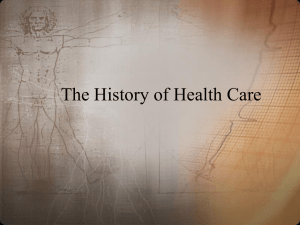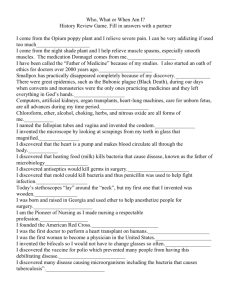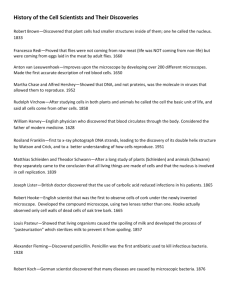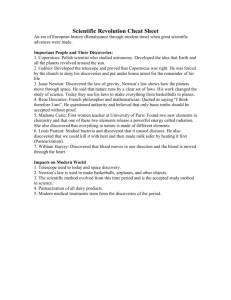4. The History of Health Care
advertisement
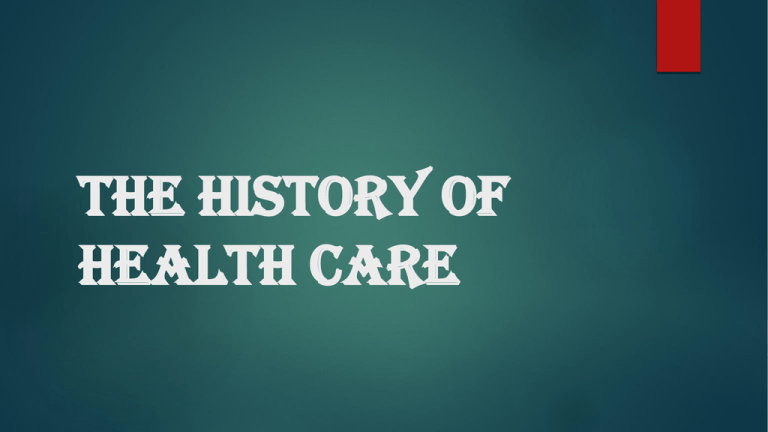
The History of Health Care Objective: Survey and research the historical significance of health care Identify key events in the history of health care Recognize people in history who have impacted the health care industry and their contributions to it Contribution to Medicine? Gabriel Fallopius Identified the fallopian tubes in females Bartolomeo Eustachio Identified the Eustachian tube leading from the ear to the throat Gabriel Fahrenheit created first mercury thermometer Florence Nightingale Founder of modern nursing The historical significance of health care The historical significance of health care provides insight into care of today and the future: 1. Significant people, places, time periods, and developments in medical history 2. Impact of disease/epidemics on historical events 3. Development of medical education 4. Development of treatments Ancient Times humans had to protect themselves against predators superstitious illness/disease caused by supernatural spirits exorcise evil spirits herbs and plants used as medicine digitalis from foxglove plant (today: pill, IV, injection; then: chewed leaves to strengthen and slow heart) quinine malaria from bark of cinchona tree (controls fever, muscle spasms, helps belladonna and atropine from poisonous nightshade plant (relieves muscle spasms especially GI pain) morphine from opium poppy (relieves severe pain) Egyptians Earliest to keep accurate health records Superstitious Called upon gods Identified certain diseases Pharaohs kept many specialists ("Dr.'s) Egyptians Priests were the doctors Temples were places of worship, medical schools, and hospitals Only the priests could read the medical knowledge from the god Thoth Magicians were also healers Believed demons caused disease Prescriptions were written on papyrus Egyptians embalming done by special priests ( NOT the doctor priests) advanced the knowledge of anatomy strong antiseptics used to prevent decay gauze similar to today's surgical gauze mummies indicated some modern day diseases arthritis kidney stones arteriosclerosis some medical practices still used enemas circumcision (4000 B.C.): preceded marriage closing wounds setting fractures Egyptians: Eye of Horus 5000 years ago magic eye: amulet to guard against disease, suffering, and evil history: Horus lost vision in attack by Seth; mother (Isis) called on Thoth for help; eye restored evolved into modern day Rx sign Jewish Medicine avoided medical practice concentrated on health rules concerning food, cleanliness, and quarantine Moses: pre-Hippocratic medical thought; studied hygiene and medicine at temple in Egypt; banned quackery (God was the only physician); Day of Rest was the greatest contribution to human welfare Greek Medicine First to study causes of diseases Research helped eliminate superstitions Diseases caused by lack of sanitation Hippocrates: no dissection, only observations; careful notes of signs/symptoms of diseases; disease Father wrote not caused by supernatural forces; of Medicine; standard of ethics which is the basis for today's medical ethics Aesculapius: staff and serpent symbol of medicine; temples built in his honor became the first true clinics and hospitals Roman Medicine learned from the Greeks and developed a sanitation system aqueducts and sewers public baths beginning of public health first to organize medical care army medicine room in doctor's house became first hospital public hygiene: flood control, solid construction of homes Dark Ages (400 – 800 A.D.) and Middle Ages (800 – 1400 A.D.) medicine practiced only in convents and monasteries: custodial care, life and death in God's hands terrible epidemics bubonic plague (Black Death); smallpox; diphtheria; syphilis; measles; typhoid fever; tuberculosis Crusaders spread disease Cities became common Special officers to deal with sanitary problems Realization of fact that disease is contagious: Quarantine Laws passed Renaissance Medicine (1350 – 1650 A.D.) Universities and medical schools for research Dissection Book publishing 16th and 17th Century Leonardo da Vinci: anatomy of the body Anton van Leeuwenhoek (1676): playing with lenses (invented microscope), Observed microorganisms William Harvey: circulation of blood Gabriele Fallopius: discovered fallopian tube Bartolemmo Eustachus: discovered tube from ear to throat Origin is from the Dutch "kwakzalver", or purveyor of salves rubbed quickly Some quackery into the skin. The making of health claims without an honest effort to validate them by the usual methods of science 18th Century Edward Jenner: 1796, smallpox vaccination Joseph Priestly: discovered oxygen Benjamin Franklin: invented bifocals, found that colds could be passed from person to person Laennec: invented the stethoscope 19th and 20th Century Ignaz Semmelweiss: identified the cause of childbed fever (puerperal fever) which led to the importance of hand washing Louis Pasteur (1860 – 1895): discovered that microorganisms cause disease (germ theory of communicable disease) Joseph Lister: used carbolic acid on wounds to kill germs; first doctor to use an antiseptic during surgery Ernest von Bergman: developed asepsis ( freedom from infection) Robert Koch: Father of Microbiology; specific germ causes specific disease; identified germ causing TB (in 1880's it killed 1 out of 7) Wilhelm Roentgen: discovered X-rays Paul Ehrlich: discovered effect of medicine on disease causing microorganisms i.e. Treatment for syphilis Anesthesia discovered (nitrous oxide, ether, chloroform) Gerhard Domagk: discovered sulfonamide drugs (1st medicine effective in killing bacteria Ivanoski: discovered viruses i.e. poliomyelitis, rabies, measles, influenza, Chickenpox, German measles, herpes zoster, mumps Alexander Fleming: discovered penicillin Jonas Salk: discovered that a killed polio virus would cause immunity to polio Alfred Sabin: discovered that a live virus provided more effective immunity 1900 to 1945 Acute infectious diseases (diphtheria, TB, rheumatic fever) No antibiotics, DDT for mosquitoes, rest for TB, water sanitation to help stop spread of typhoid fever, diphtheria vaccination Hospitals were places to die Most doctors were general practitioners 1945 to 1975 Immunization common antibiotic cures safer surgery transplants increased lifespan chronic degenerative diseases new health hazards (obesity, neuroses, lung cancer, hypertension) disintegrating families greatly increasing medical costs 1975 to present Artificial parts Bioengineering Cloning Bioethical issues AIDS Drug resistant organisms Laser surgeries Laparoscopic surgeries Managed health care, ..etc.
